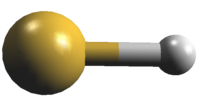|
The transition frequencies have been reevaluated
once more with respect to earlier entries from
Sep. 2014, Apr. 2009, and Aug. 2008. Details are
given in
(1) S. Muller, H. S. P. Müller, J. H. Black, M. Gérin,
F. Combes, S. Curran, E. Falgarone, M. Guélin, C. Henkel,
S. Martín, K. M. Menten, E. Roueff, S. Aalto, A. Beelen,
T. Wiklind, and M. A. Zwaan,
2017, Astron. Astrophys. 606, Art. No. A109.
New N = 1 – 0 transition frequencies,
except one, were taken from
(2) D. T. Halfen and L. M. Ziurys,
2015, Astrophys. J. 814, Art. No. 119;
see (1) for details; the correct transition frequency was
estimated there. Additional, albeit redundant and less accurate
frequency information was taken from
(3) C. Savage, A. J. Apponi, and L. M. Ziurys,
2004, Astrophys. J. 608, L73;
and from
(4) H. S. P. Müller, J. R. Goicoechea, J. Cernicharo,
M. Agúndez, J. Pety, S. Cuadrado, M. Gerin, G. Dumas,
and E. Chapillon,
2014, Astron. Astrophys. 569, Art. No. L5.
In addition, extrapolated zero-field transition frequencies
from
(5) J. M. Brown and H. S. P. Müller,
2009, J. Mol. Spectrosc. 255, 68
were used in the fit. These were derived from laser
magnetic resonance measurements in
(6) D. C. Hovde and R. J. Saykally,
1987, J. Chem. Phys. 87, 4332.
Also used in the fit were infrared transition
frequencies up to v = 2 – 1
and 4 – 3, respectively, from
(7) P. R. Brown, P. B. Davies, and S. A. Johnson,
1986, Chem. Phys. Lett. 132, 582;
and from
(8) S. Civiš, C. E. Blom, and P. Jensen,
1989, J. Mol. Spectrosc. 138, 69.
Predictions with uncertainties exceeding 0.3 MHz
should be viewed with some caution.
Predictions with uncertainties exceeding 3 MHz
or with ΔJ ≠ ΔN
should be viewed with greater caution.
The dipole moment is from an ab initio calculation
from
(9) J. Senekowitsch, H.-J. Werner, P. Rosmus,
E.-A. Reinsch, and S. V. O'Neil,
1985, J. Chem. Phys. 83, 4661.
|
